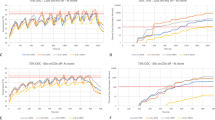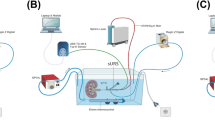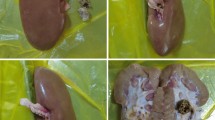Abstract
As laser technology has advanced, high-power lasers have become increasingly common. The Holmium: yttrium–aluminum-garnet (Ho:YAG) laser has long been accepted as the standard for laser lithotripsy. The thulium fiber laser (TFL) has recently been established as a viable option. The aim of this study is to evaluate thermal dose and temperature for the Ho:YAG laser to the TFL at four different laser settings while varying energy, frequency, operator duty cycle (ODC). Utilizing high-fidelity, 3D-printed hydrogel models of a pelvicalyceal collecting system (PCS) with a synthetic BegoStone implanted in the renal pelvis, laser lithotripsy was performed with the Ho:YAG laser or TFL. At a standard power (40W) and irrigation (17.9 ml/min), we evaluated four different laser settings with ODC variations with different time-on intervals. Temperature was measured at two separate locations. In general, the TFL yielded greater cumulative thermal doses than the Ho:YAG laser. Thermal dose and temperature were typically greater at the stone when compared away from the stone. Regarding the TFL, there was no general trend if fragmentation or dusting settings yielded greater thermal doses or temperatures. The TFL generated greater temperatures and thermal doses in general than the Ho:YAG laser with Moses technology. Temperatures and thermal doses were greater closer to the laser fiber tip. It is inconclusive as to whether fragmentation or dusting settings elicit greater thermal loads for the TFL. Energy, frequency, ODC, and laser-on time significantly impact thermal loads during ureteroscopic laser lithotripsy, independent of power.




Similar content being viewed by others
Data availability
The raw data as been included as a supplementary file and is available for review.
Abbreviations
- RIRS::
-
Retrograde Intrarenal Surgery
- Ho:YAG:
-
Holmium:Yttrium–aluminum-garnet
- URS:
-
Ureteroscopic retrograde surgery
- TFL:
-
Thulium Fiber Laser
- TD43 :
-
Threshold of thermal injury
- CEM:
-
Cumulative equivalent minutes
- PCS:
-
Pelvicalyceal collecting system
- CFD:
-
Computational fluid dynamics
- PVA:
-
Polyvinyl alcohol
- ODC:
-
Operator duty cycles
- DICOM:
-
Digital Imaging and Communications in Medicine
- CAD:
-
Computer-aided design
- AUC:
-
Area under the curve
References
Rezakahn Khajeh N, Majdalany SE, Ghani KR (2021) Moses 2.0 for high-power ureteroscopic stone dusting: clinical principles for step-by-step video technique. J Endourol 35(S3):S22–S28
Dauw CA et al (2015) Contemporary practice patterns of flexible ureteroscopy for treating renal stones: results of a worldwide survey. J Endourol 29(11):1221–1230
Aldoukhi AH et al (2020) Defining thermally safe laser lithotripsy power and irrigation parameters. J Endourol 34(1):76–81
Pauchard F et al (2022) A practical guide for intra-renal temperature and pressure management during rirs: what is the evidence telling us. J Clin Med 11(12):3429
Traxer O, Keller EX (2020) Thulium fiber laser: the new player for kidney stone treatment? A comparison with Holmium:YAG laser. World J Urol 38(8):1883–1894
Belle JD et al (2022) Does the novel thulium fiber laser have a higher risk of urothelial thermal injury than the conventional holmium laser in an. J Endourol 36(9):1249–1254
Sapareto SA, Dewey WC (1984) Thermal dose determination in cancer therapy. Int J Radiat Oncol Biol Phys 10(6):787–800
Maxwell AD et al (2019) Simulation of laser lithotripsy-induced heating in the urinary tract. J Endourol 33(2):113–119
Aldoukhi AH et al (2017) Thermal response to high-power holmium laser lithotripsy. J Endourol 31(12):1308–1312
Ghazi A, Melnyk R, Cook A et al (2022) PD37–06 Comparison Of computational simulation and hydrogel kidney phantoms for in vivo assessment of intrarenal pressure (IRP) dynamics during ureteroscopy under various experimental conditions. J Urol 207:e641
Saba P et al (2020) Development of a high-fidelity robot-assisted kidney transplant simulation platform using three-dimensional printing and hydrogel casting technologies. J Endourol 34(10):1088–1094
Braunstein L et al (2022) Characterization of acoustic, cavitation, and thermal properties of poly(vinyl alcohol) hydrogels for use as therapeutic ultrasound tissue mimics. Ultrasound Med Biol 48(6):1095–1109
Louters MM et al (2022) Laser operator duty cycle effect on temperature and thermal dose: in-vitro study. World J Urol 40(6):1575–1580
Dau JJ et al (2021) Effect of chilled irrigation on caliceal fluid temperature and time to thermal injury threshold during laser lithotripsy. J Endourol 35(5):700–705
Aldoukhi AH et al (2021) Patterns of laser activation during ureteroscopic lithotripsy: effects on caliceal fluid temperature and thermal dose. J Endourol 35(8):1217–1222
Chua ME et al (2023) Thulium fibre laser vs holmium: yttrium-aluminium-garnet laser lithotripsy for urolithiasis: meta-analysis of clinical studies. BJU Int 131(4):383–394
Molina WR et al (2021) Temperature rise during ureteral laser lithotripsy: comparison of super pulse thulium fiber laser (SPTF) vs high power 120 W holmium-YAG laser (Ho:YAG). World J Urol 39(10):3951–3956
Taratkin M et al (2020) Temperature changes during laser lithotripsy with Ho:YAG laser and novel Tm-fiber laser: a comparative in-vitro study. World J Urol 38(12):3261–3266
Andreeva V et al (2020) Preclinical comparison of superpulse thulium fiber laser and a holmium:YAG laser for lithotripsy. World J Urol 38(2):497–503
Petzold R, Suarez-Ibarrola R, Miernik A (2021) Temperature assessment of a novel pulsed thulium solid-state laser compared with a holmium:yttrium-aluminum-garnet laser. J Endourol 35(6):853–859
Kronenberg P, Traxer O (2019) The laser of the future: reality and expectations about the new thulium fiber laser-a systematic review. Transl Androl Urol 8(Suppl 4):S398–S417
Acknowledgements
We would like to graciously thank Dr. William Roberts, MD from the University of Michigan for providing his expertise, input, and guidance in our project. We largely based our project on the excellent work his lab has produced. He reviewed our data and provided insight for data evaluation to provide impactful results.
Funding
There was no source of funding for this project.
Author information
Authors and Affiliations
Contributions
All of the listed authors contributed substantially to the production of this research and manuscript.
Corresponding author
Ethics declarations
Conflicts of interest
There are no conflicts of interest for any author included in the production of this manuscript.
Additional information
Publisher's Note
Springer Nature remains neutral with regard to jurisdictional claims in published maps and institutional affiliations.
Supplementary Information
Below is the link to the electronic supplementary material.
240_2024_1541_MOESM1_ESM.jpg
Supplementary file1 Figure S1. Graphs of each laser setting for TFL at the stone for 50% ODC, 30s on/ 30s off for (A) temperature and (B) thermal dose. 50% ODC, 60s on/ 60s off for (C) temperature and (D) thermal dose (JPG 371 KB)
240_2024_1541_MOESM2_ESM.jpg
Supplementary file2 Figure S2. Graphs for thermal dose comparing Ho:YAG vs. TFL for 50% ODC. 30s on/ 30s off for (A) 1J x 40Hz, (B) 2J x 20Hz, (C) 0.5J x 80Hz, (D) 0.4J x 100Hz. 60s on/ 60s off for (E) 1J x 40Hz, (F) 2J x 20Hz, (G) 0.5J x 80Hz, (H) 0.4J x 100Hz. (JPG 938 KB)
Rights and permissions
Springer Nature or its licensor (e.g. a society or other partner) holds exclusive rights to this article under a publishing agreement with the author(s) or other rightsholder(s); author self-archiving of the accepted manuscript version of this article is solely governed by the terms of such publishing agreement and applicable law.
About this article
Cite this article
Wanderling, C., Saxton, A., Phan, D. et al. Getting hot in here! Comparison of Holmium vs. thulium laser in an anatomic hydrogel kidney model. Urolithiasis 52, 49 (2024). https://doi.org/10.1007/s00240-024-01541-y
Received:
Accepted:
Published:
DOI: https://doi.org/10.1007/s00240-024-01541-y




